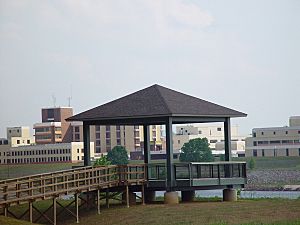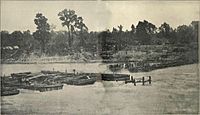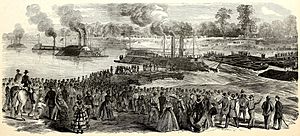Bailey's Dam facts for kids
Quick facts for kids Bailey's Dam |
|
|---|---|

Remnants of Bailey's Dam in 1984
|
|
| Location | Alexandria / Pineville, Louisiana |
| Construction began | April 28, 1864 |
| Opening date | May 8, 1864 |
| Demolition date | May 13, 1864 |
| Dam and spillways | |
| Type of dam | Rock-crib |
| Impounds | Red River |
| Height | ~7 ft. |
| Length | ~758 ft. |
|
Bailey's Dam Site
|
|
| Location | Red River S of U.S. 71, Alexandria, Louisiana |
| Area | 8 acres (3.2 ha) |
| Built | 1864 |
| NRHP reference No. | 76000973 |
| Added to NRHP | June 29, 1976 |
Bailey's Dam was a special wooden dam built on the Red River in Alexandria, Louisiana. It was built in 1864 during the American Civil War. This was part of the Red River Campaign. The dam was designed by Lieutenant Colonel Joseph Bailey. Its main goal was to help Union Navy ships pass over shallow parts of the river. These ships belonged to Rear Admiral David Dixon Porter's fleet. The dam successfully raised the river's water level. This allowed the ships to move downstream safely.
Contents
Why the Dam Was Needed
The Red River was a key waterway for travel in Louisiana. Near Alexandria, the river flowed over two rocky ledges. These ledges made the water very shallow. This was a big problem for boats.
The Red River Campaign
In March 1864, Union General Nathaniel P. Banks led his troops north. They moved along the Red River to try and capture Shreveport. Rear Admiral David Dixon Porter and his fleet of ships went with them. The river was unusually low at this time. This made it very hard for the ships to pass.
Only 12 gunboats and 20 transport ships could get past the shallow areas near Alexandria. The rest of the fleet had to wait. After a battle, General Banks's troops had to retreat south. Admiral Porter's ships also struggled to move back down the river.
A Big Problem for the Fleet
By April 28, the fleet reached the Alexandria falls again. The river was only about 3 feet deep. But Porter's ships needed 7 feet of water to pass safely. There was no time to wait for the river to rise naturally.
Lieutenant Colonel Joseph Bailey, an engineer, had an idea. He suggested building a special dam. Bailey had experience building dams as a lumberman in Wisconsin. He knew how to solve this kind of problem. Even though some officers doubted his plan, General Banks agreed. He ordered the dam to be built right away.
Building Bailey's Dam
Construction started quickly under Bailey's supervision. About 3,000 soldiers worked on the dam. They cut down trees and brought rocks, bricks, and other materials. The dam was built across the 758-foot-wide (231 m) river. It was placed at the bottom of the shallow ledge.
Soldiers from the 29th Maine Volunteer Infantry Regiment used their logging skills. They built parts of the dam from the left side of the river. Freed slaves from the 97th and 99th United States Colored Infantry Regiments worked from the right side. They built strong wooden frames called "box cribs." These cribs were filled with rocks and stones.
The dam was made of wooden timbers. These timbers were stacked parallel to the river. Stones held the upstream parts in place. Other timbers were placed across the river to support the dam. This made it stronger as water built up behind it. The dam did not go all the way across the river. Four coal barges were sunk in the 150-foot (46 m) gap. These barges were filled with local materials. One barge was only partly filled. Bailey planned to remove it quickly to let the water out. Materials from the Red River Railroad were also used.
The Dam's Success
By May 6, the dam had raised the river level to four feet. By May 8, it was over five feet deep. This allowed some smaller boats to pass.
On May 9, two of the barges in the dam broke loose. A rush of water flowed downstream. Only four of Porter's ships, including the Lexington, managed to pass through. The other ships were not ready. Bailey quickly repaired the dam. He also decided to build two smaller dams upstream. These new dams were finished by May 11. They helped guide the water into a deeper channel. They also reduced pressure on the main dam.
On May 13, the main dam was repaired. The gunboat Mound City then broke through it. Soon, the rest of the fleet was safely below the falls. Bailey's Dam saved Admiral Porter's fleet.
Bailey's Dam Today

Bailey's Dam Site was added to the National Register of Historic Places in 1976. You could see parts of the dam during low river levels. However, in 1987, the U.S. Army Corps of Engineers built a new dam downstream. This new dam, the John Overton Lock and Dam, caused the site to be flooded. Before it was flooded, the Corps of Engineers studied the area in 1984. These studies helped confirm the historical stories about the dam.
- Historic American Engineering Record (HAER) No. LA-6, "Bailey's Dam, Red River, Alexandria, Rapides Parish, LA", 21 photos, 12 data pages, 2 photo caption pages
Images for kids





